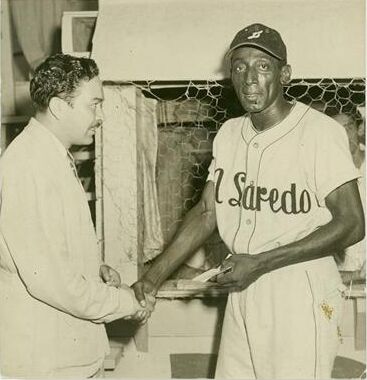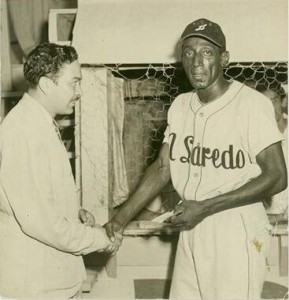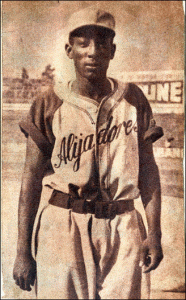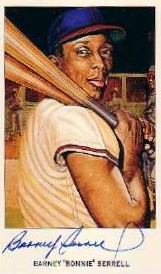Historical Hitter September 29 1942: Barney Serrell

Today the focus is on batters and in this case the batting hero the day from September 29 comes from the 1942 Negro League World Series. The batting hero of the day is Barney Serrell of the Kansas City Monarchs. His 10 hits in a 4-game World Series ties the Babe’s record set in 1928. Serrell’s hitting lead the Monarchs over the Homestead Grays to capture the title, with today’s victory being a 9-5 victory in Shibe Park in Philadelphia. The Serrell’s line for the series was:
| Name | Age | Bats | Pos | G | AB | R | H | 2B | 3B | HR | RBI | BB | SB | BA | OBP | SLG |
| Serrell | 22 | L | 2B | 4 | 18 | 2 | 10 | 1 | 1 | 0 | 5 | 1 | 0 | .556 | .579 | .722 |
 Serrell was a man of many nicknames which ranged from: Barney, Bonnie, Cricket, El Cura, El Grillo, and William C. His fielding skills were graceful and flowing, he covered so much ground at second base he was also garnered the Brooks Robinson moniker “The Vacuum Cleaner” nickname. He was a star player in both the Negro Leagues and in Mexico, Cuba, Puerto Rico, and in the Pacific Coast League from the 1941 to 1958.
Serrell was a man of many nicknames which ranged from: Barney, Bonnie, Cricket, El Cura, El Grillo, and William C. His fielding skills were graceful and flowing, he covered so much ground at second base he was also garnered the Brooks Robinson moniker “The Vacuum Cleaner” nickname. He was a star player in both the Negro Leagues and in Mexico, Cuba, Puerto Rico, and in the Pacific Coast League from the 1941 to 1958.
For the Monarchs he played second base and was the key to their 1942 Title. In 1973 Frank Duncan writing the Journal of Black Sports described Serrell as the best ballplayer on the Monarchs.
“Jackie was not the best player of our team that year; No, he was not. I met and had a young boy named “Bonnie” Serrell at second base, thin and large hitador, oh man!, he could hit out of this world.”
He broke in with the Monarchs by hitting over .400 although he had an aggressive swing, never one for working the count to take a walk, he was not known for striking out. In 1942 while he was in Mexico, Jackie Robinson replaced him at second base for the Monarchs.
 His best statistical years were in Mexico in the 1940’s. Being out of the country got him in trouble with the draft board, for when he was drafted, he was south of the border, and thus unaware of the draft notices. He was at the top of the league leaders in Mexico in doubles and triples and batting average during that time period, and noted for always having a good luck toothpick in his mouth day or night, at the plate or in the field, and even after the games. Toothpick or not he was a superior player. Baseball-reference.com notes that Serrell hit .311/.366/.434 with 90 steals in 863 games in the Mexican League with just 171 strikeouts in 3,539 AB. He hit 66 triples, just missing the top 20 all-time through 2000.
His best statistical years were in Mexico in the 1940’s. Being out of the country got him in trouble with the draft board, for when he was drafted, he was south of the border, and thus unaware of the draft notices. He was at the top of the league leaders in Mexico in doubles and triples and batting average during that time period, and noted for always having a good luck toothpick in his mouth day or night, at the plate or in the field, and even after the games. Toothpick or not he was a superior player. Baseball-reference.com notes that Serrell hit .311/.366/.434 with 90 steals in 863 games in the Mexican League with just 171 strikeouts in 3,539 AB. He hit 66 triples, just missing the top 20 all-time through 2000.
Sadly he never made it to the Big’s but played winter league ball in California and for the Yakima Bears and PCL Seals. Sadly his PCL years were near the end of this career, so his hitting and fielding skills were not at their peak, he batted less than .250 as the Seals were having one of their worst years the went 74-93 finishing 8th in the PCL. In 1951 the Seals were affiliated with the Yankees, and it was long-time manager Lefty O’Doul’s last season with the famed club. He was clearly a baseball man, and was selected as one of the few African American managers in the minors. He was player-manager for the Indios de Ciudad Juarez of the Mexico-Arizona league in the late 1950’s. He did not last the season as manager but continued as a player. A list of teams he played for include:
- Kansas City Monarchs (1942-1945)
- California Winter League (1944-1945)
- Alijadores de Tampico (1945-1947)
- Veracruz Azulez (1948)
- San Luis Potosi Tuneros (1948)
- Yakima Bears (1951)
- San Francisco Seals (1951)
- Monterry Sultanes (1957)
- Tecolotes de Nuevo Laredo (1952-1957)
- Indios de Ciudad Juárez (1957-58)
 The information on Serrell is incomplete, and although he played with many players such as with Jackie, Hank Thompson, Elston Howard, and Satchel Paige who broke the color barrier for numerous teams, he was never given the chance to do so; it’s one more of the great injustice that plagues the game’s history.
The information on Serrell is incomplete, and although he played with many players such as with Jackie, Hank Thompson, Elston Howard, and Satchel Paige who broke the color barrier for numerous teams, he was never given the chance to do so; it’s one more of the great injustice that plagues the game’s history.
Serrell was born in Natchez, Louisiana on March 9, 1920 and died in northern California in East Palo Alto on August 15, 1996, aged 76. During his baseball days he batted left and threw right handed.
Today was the day of the greatest catch, and a play that can never be replicated. Vic Wertz’s drive would have been a powerfully struck home run in just about any other ballpark in that day (may be not Griffith Park) and of course in any the current ballparks. Caught by Willie Mays in game one of the 1954 World Series in deep centerfield at the long gone Polo Grounds Wertz’s 440+? ft. blast was the turning point in the game and the series. The heavily favored and winners of then an AL record 110 games Indians were swept in 4 games by the Giants.
Just three years later in 1957, both the Giants and Dodgers played their last games as New Yorkers, not surprising, both teams lost. It is one of baseball’s eternal rewards that on this day in 1962, the next National League Club representing New York, actually won a game on this date 2-1. It was pitcher Bob Miller’s only win that year – he went 1-12. Coincidently, it was also the last game for des Expos de Montréal who lost 9-1, the same score as the Giants. On the positive move side, on this day in 1953 it was announced that it was thankfully the end of the woefully inept Brownies, and the new Orioles were returning baseball joy to Charm City.
The Babe also hit his last home run as a New York Yankee on this day in Griffith Stadium in 1934, given the ample outfield enclosed by home run unfriendly walls in that Washington. DC ballpark, it no doubt was a veritable Ruthian blast.
As its pennant clinching time of late September, two of baseball’s worst franchises (two of the three franchises members of the ten-thousand lost game club) both clinched on this day in sequential years of 1914 and 1915. The later winner, from William Penn’s city would have to wait until the days of double-knit light blue uniforms and Astroturf to win their first title.
[divider]
Sources For William Serrell
http://www.out27.com/columnas/jrubio/jrubio_09120601.htm
Riley, James A. (1994). The Biographical Encyclopedia of the Negro Baseball Leagues. New York: Carroll & Graf. ISBN 0-7867-0959-6.
http://www.historiadehermosillo.com/htdocs/BASEBALLCOSTA/costa/1947-1948/Williamserrell.htm
Wikipedia, See Barney Serrell.
http://www.nlbpa.com/the-athletes/serrell-william—barney
